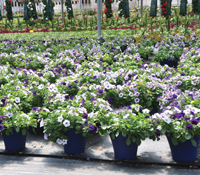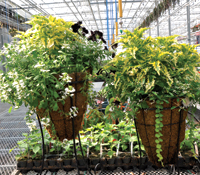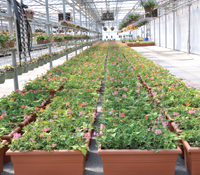
Every living thing needs a mechanism to recharge; the minute we ignore
this process, or it is uncontrollable, we cannot accomplish the
“recharging process.”
Every living thing needs a mechanism to recharge; the minute we ignore this process, or it is uncontrollable, we cannot accomplish the “recharging process.” The greenhouse business is no different. Here is a snapshot of the bedding plant crop changes for the past 30 years and some factors that did help transform different operations to what they are now.
 |
|
| Display gardens inside a garden centre are effective sales tools. PHOTOS COURTESY MELHEM SAWAYA Advertisement
|
Some 30 years ago, the North American bedding plant industry was the smallest segment in the greenhouse business. Today, it is the largest. Sales are estimated to be over $3 billion (US). During this period, the industry evolved from:
- Growing plants in heavy soil … to soilless mixes.
- Banana crates … to the plastic coded containers.
- From no tags … to specific UPC tags.
- From sowing by hand in open seed flats … to using plugs and automatic transplanters.
- From transplanting bare-root seedlings by hand … to transplanting plugs with automatic transplanters.
- From growing varieties we like … to being forced to grow specific varieties selected by the buyer.
- From hardly any service or delivery … to making a 24-hour delivery promise.
- From growers servicing a small customer base … to large growers with a large customer base.
- From the consumer being the direct buyer … to one buyer for thousands of consumers.
- From building greenhouses to produce plants … to building greenhouses from which buyers sell.
- From one truck with a few boards … to a trucking company with a cart delivery system that can easily amount to 10 to 15 per cent of production costs.
 |
|
| How about a mainly foliage hanging basket? |
The point is that things are changing fast. If we don’t adjust and keep pace or anticipate these changes, it will only be a
matter of time before we are no longer in business.
DEALING WITH FEWER RETAIL BUYERS
Department store chains and supermarkets control 70 per cent of sales. Some of these chains or supermarkets have more than 200 stores, with only one buyer making the decisions for all of them. Since he or she has the responsibility to co-ordinate these sales, it is much simpler for them to deal with only a few suppliers with whom they feel comfortable and confident that they will deliver as promised.
There are only three options here:
- Sell the business.
- Let the bank take the business!
- Adjust.
- If you decided to pick one of the first two choices, it is easy – just don’t do anything and it will happen sooner or later. If you choose the third option, there are some guidelines to use when assessing:
- Your strengths and weaknesses.
- Your financial situation.
- Your needs.
- Your goals.
 |
|
| These combinations in fancy gallon containers are easily upgraded to personal containers or instant beds.
|
BUILDING ON STRENGTHS, UNDERSTANDING WEAKNESSES
Every greenhouse owner has some strengths and some weaknesses. Differentiating between them is much easier than you think. Results don’t lie. If your efforts in a certain area produce favourable results, such as costing, actual growing, sales, shipping, etc., then obviously this is strength for you. However, if every season you face the same situation and it leaves you feeling frustrated and helpless, then obviously this is a weak area for you.
There are two approaches to problem-solving:
- Recognize that a specific problem is a weak area for you and that you can’t ignore it. If you cannot pinpoint the exact problem, ask somebody else to point it out and then do something to correct it.
- If you don’t think you have any weaknesses, and every problem is somebody else’s fault … or you blame it on Mother Nature or your bad luck … then you are a dreamer and should never run your own business. You should work for someone else where, for sure, they will point out your weaknesses and will build on your strengths.
 |
|
| Large containers remain popular.
|
Before we go on, let’s take a moment and look at the development of the greenhouse industry in North America.
Since the 1960s, this industry has been mushrooming. In the 1960s, many ambitious individuals started new greenhouse operations, worked hard and established successful businesses. In general, these individuals were in their 30s, which means many are now retired.
Also during this period, their kids went to school. Some returned to work on the farm. Others, who saw how hard their parents were working, didn’t want anything to do with the business.
The group that joined the business had their first job on the family farm and their parents as their only boss.
So how is a person going to learn to recognize his or her strengths or weaknesses when the only people to judge them are their parents? The fact is that young people hardly ever accept feedback from their parents, since the comment are generally perceived as punishment. For their part, many parents keep reminding their kids that they built the business from nothing … so they had better listen.
It’s not always an ideal learning/teaching situation.
 |
|
| Container sales remain strong.
|
SETTING UP A GROWER EXCHANGE PROGRAM
In my opinion, there is a solution. A grower exchange program would allow young family members to work at other farms. Let them work for someone else for two or three years before coming back to the family business. This would help them better understand their strengths. As well, they will have more appreciation for the family business upon their return.
The biggest challenge in business is working with people. God created the world in six days but He is still working on us!
 |
|
| Funky containers, anyone?
|
No, we didn’t drift from our main topic; the most important issue is people and our industry is primarily made up of family businesses. (Of course, there are many other factors to consider in making our businesses more profitable.)
It’s so important to know our customers and for them to know us, so that everyone is on the same wavelength. The more those buyers understand our business, the more they appreciate our efforts. At the same time, they know what they can expect from us, so we had better deliver.
Maintaining good communication with buyers and a determination to work with them is a must to keep the business and make it more profitable.
 |
|
| Consumers like large window boxes; are you growing any?
|
During the 30-plus years I’ve been involved in this business, I’ve noticed that those owners who keep looking for new ways to recharge their businesses are continuing to grow. However, those who think that whatever worked in the past will continue to work in the future may not be in business for very long.
Industry coordination and vision is needed. There is always more strength in numbers as long as everyone is pulling towards the same goal!
Melhem Sawaya of Focus Greenhouse Management is a consultant and research coordinator to the horticultural industry. Comments on this or any other article are always welcome; please e-mail mel@focusgreenhousemanagement.com, or visit www.focusgreenhousemanagement.com.
Print this page